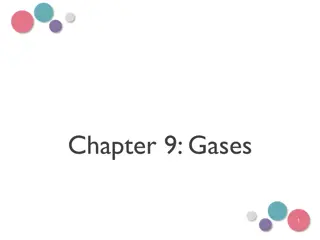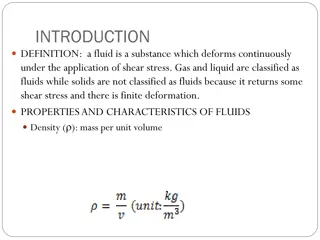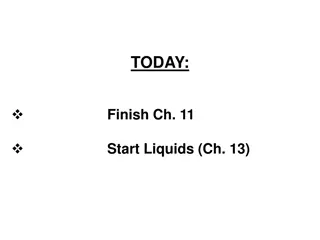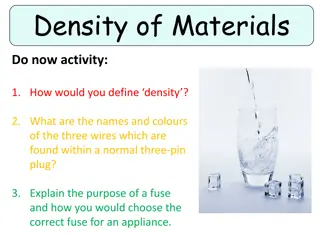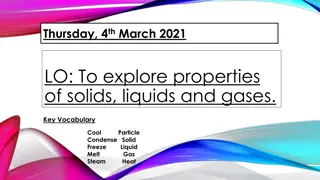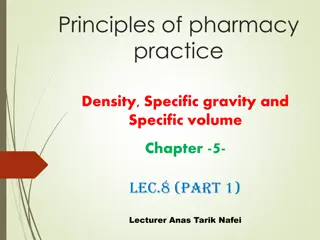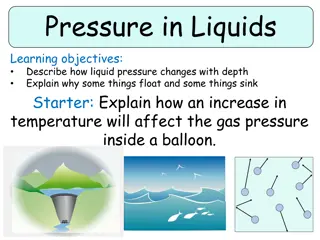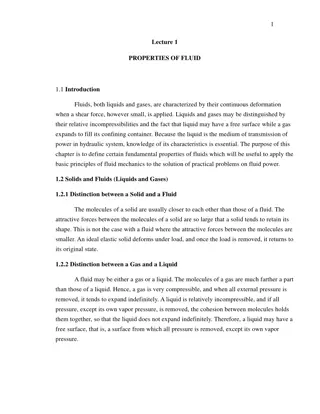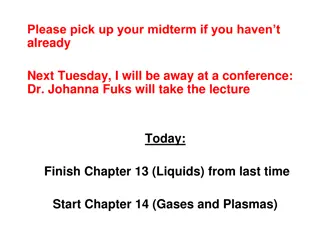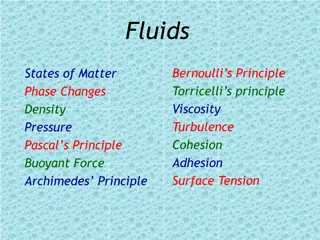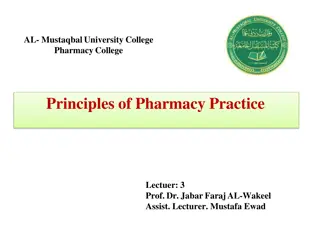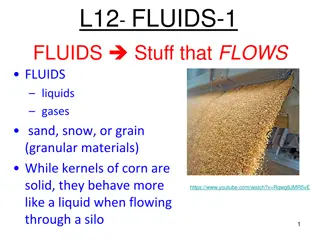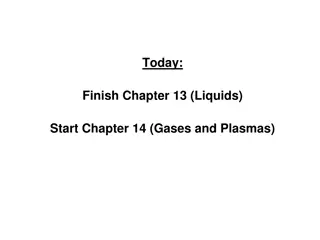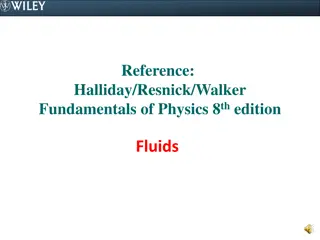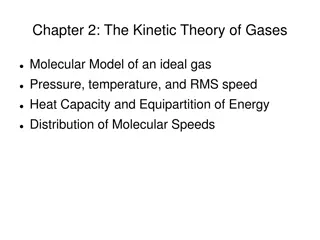Understanding Fluids: Density, Specific Gravity, and Pressure in Liquids and Gases
Fluids such as liquids and gases possess properties like density, specific gravity, and pressure that play a crucial role in their behavior. Density measures the heaviness of a material, while specific gravity compares the mass of a material to that of water. Pressure affects the density of fluids, and instruments like pressure gauges help measure it. Examples and calculations demonstrate these concepts in action, providing a deeper understanding of fluid mechanics.
Download Presentation

Please find below an Image/Link to download the presentation.
The content on the website is provided AS IS for your information and personal use only. It may not be sold, licensed, or shared on other websites without obtaining consent from the author. Download presentation by click this link. If you encounter any issues during the download, it is possible that the publisher has removed the file from their server.
E N D
Presentation Transcript
Chapter 14 Fluids(liquid, gas) Something that can flow is fluid
Density Density of a fluid (liquid and gas) having a mass m and a volume V is given by Density (Kg/m3) Material State Water (fresh) 1000 At STP m = Water (salt) 1030 V 850 1400 Density Units: kg/m3 Plastics Magnesium 1740 At STP Density measures the heaviness of the material Beryllium 1850 At STP Glycerol[8] 1261 Silicon 2330 At STP Aluminium 2700 At STP Diamond 3500 At STP Titanium 4540 At STP Selenium 4800 At STP The Earth 5515.3 liquid gas
Specific gravity (S.G) Do you know mass of 1 cm3 (cc) water = 1 g? 1 Kg of water 1 liter (1000 cc) water Specific gravity measures the heaviness of any material compare to water W Weight = = G . . G . . S S prove W w w Table salt has a specific gravity of 2.17, so it is 2.17 times as dense as water. Aluminum has a specific gravity of 2.7, so it is 2.7 times as dense as water. Iron has a specific gravity of 7.87, so it is 7.87 times as dense as water. Lead has a specific gravity of 11.35, so it is 11.35 times as dense as water. Mercury has a specific gravity of 13.56, so it is 13.56 times as dense as water. Gold has a specific gravity of 19.3, so it is 19.3 times as dense as water. Osmium, the densest naturally occurring chemical element, has a specific gravity of 22.59, so it is 22.59 times as dense as water.
Pressure F F A A liquid gas IF YOU CHANGE PRESSURE DENSITY CHANGES Pressure on the fluid F P = A Pressure changes temperature and temperature changes density Pressure Units: N/m2 (Pascal)
Fluid at rest = + F F mg b t F F mg = + b t A = A A = m V Ah Ft Fb Ahg F F h = + Ft b t A A A mg mg = P + P P gh gh b t = P b t Consider an imaginary fluid body which is in equilibrium If Pt = P0 and Pb = P = P P gh 0 Gauge pressure (Pg) = P P0 Example1: If 1 atmospheric pressure is 1.01 x 105 Pa find the pressure at 1 Km above the earth surface. (density of air is 1.2Kg/m3) = Pg gh
Pressure Measurement Pressure gauge which is used to measure the fluid pressure inside: t h b Fluid compresses the spring which is translated in terms of pressure Mercury F kx = = P = P P gh A A b t Pb= = 0 0 P tP Example2: If 1 atmospheric pressure is 760 mm of Hg find it in Pascal. (density of mercury is 13.6 g/cc) = P gh 0 . 1 = 5 01 10 P Pa 0
Examples Ans: All Tie (height is same) T92-Q26. Figure 7 shows a snapshot of a fluid within a U-shaped tube that has both sides open at the top. Is this fluid in static equilibrium at this instant? A) No, because the fluid level in both sides should be at the same height. B) No, because the fluid level in side A should be lower than that in side B. C) No, because the cross-sectional area of side A is less than that of side B. D) Yes, the fluid is in static equilibrium. E) The answer may be yes or no, depending on the density of the fluid.
T71-Q8. The pressure of a gas in a tank is measured with a mercury manometer (Fig. 5). The mercury is 36.2 cm higher in the outside arm than in the arm connected to the gas cell. Find the gauge pressure of the gas cell. (Density of mercury is 13.6 g/cm3) Ans: 4.82 104 Pa T101-Q22. The pressure on a submarine is 1.00 x 106 Pa. Assume that the density of seawater is 1.20 x 103 kg/m3. The depth of the submarine below the surface of seawater is: A) 76.4 m T81-Q25. A vertical cross section of a simple geological model of the earth that requires mountains to have roots is shown in Figure 10. At some horizontal level in the fluid mantle (called the level of compensation), the pressure has a constant value (the pressures at points A and B in the figure are equal). How deep must the root (d) of the mountain approximately be? A) 13 km
T62-Q9. A U-tube of constant cross sectional area, open to the atmosphere, is partially filled with Hg ( Hg=13.6 g/cm3). Water ( w=1.00 g/cm3) is then poured into both arms. If the equilibrium configuration of the tube is as shown in the Fig. 5 with h3= 1.00 cm, determine the value of h1. (Note that h1, h2 and h3 are not drawn to scale). A) 12.6 cm Fig-5 T102-Q22. A U-shaped tube open at both ends contains water and a quantity of oil occupying a 2.0 cm length of the tube, as shown in Figure 10. If the density of oil is 82% of the density of water, what is the height difference h? A) 0.36 cm T82-Q11. The open vertical tube in Fig. 3 contains three fluids of densities 1 = 300 kg/m3, 2 = 400 kg/m3 and 3 = 500 kg/m3, which do not mix. Find the pressure at point B. A) 1.03 x 105Pa
T81-Q24. On a standard day (atmospheric pressure), a pressure gauge instrument below the surface of the ocean (Specific Gravity = 1.025) reads an absolute pressure of 1.4 x 106 Pa. How deep underwater is this instrument? A) 129 m T61-Q23. The open vertical tube in Fig. 13 contains two liquids of densities 1 = 1000 kg/m3 and 2 = 800 kg/m3, which do not mix. Find the gauge pressure (pressure due to the liquids only) at the bottom of the tube. (A: 9000 Pa ) Fig-13 T51-Q#24: Fig. 7 shows a U-tube with cross-sectional area A and partially filled with oil of density . A solid cylinder, which fits the tube tightly but can slide without friction, is placed in the right arm. The system is in equilibrium. The weight of the cylinder is: (Ans: AL g)
Pascals law Definition: A change in pressure applied to an enclosed incompressible fluid is transmitted to every portion of the fluid and to the walls of its container. Fin inlet Aout outlet Ain dout din Fout Inlet pressure = Outlet pressure P = P Should energy be conserved? in out W = F d F F = ) 1 ( in out Using (1) and (2) you can prove A A in out Volume of displaced fluid must conserve W = W in out V = V in out Yes! Energy does conserve. = ) 2 ( d A d A in in out out
Ch14-Q9: A piston of cross-sectional area a is used in a hydraulic press to exert a small force of magnitude f on the enclosed liquid. A connecting pipe leads to a larger piston of cross-sectional area A (see figure). (a) What force magnitude F will the larger piston sustain without moving? (b) If the piston diameters are 3.8 cm and 53 cm, what force magnitude on the small piston will balance a 20 kN force on the large piston? a) fA/a (b) 103 N f F A a
T42-Q11 A piston of radius R1= 5.0 cm is used in a hydraulic press to exert a force F1 on the enclosed liquid to raise a car of weight F2=13,500 N (see Fig 4). If the radius of the larger piston is R2 = 15 cm, Find F1. (Ans: 1.5x103N) T92-Q23. The hydraulic jack shown in Figure 5 is used to raise the mass M through a height of 5.0 mm by performing 500 J of work on the small piston. The diameter of the large piston is 10 cm while that of the small piston is 2.0 cm. The mass M is: A) 1.0 x 104 kg T102-Q21. In the hydraulic lift of Figure 9, a large piston of diameter d1 = 120 cm supports a car of mass 3.20 103 kg. What is the magnitude of the vertically downward force F1 that must be applied to the smaller piston of diameter d2 = 15.0 cm to balance the car? A) 4.90 102 N
Submerging (Immerging) Displaced liquid Displaced liquid Volume of the body inside the liquid Volume of the displaced liquid Mass of the displaced liquid = lV Weight of the displaced liquid = lVg
Buoyant Force (Fb) FB mg When the body is inside the liquid it will experience the upward force called Buoyant force (FB). Displaced liquid FB When will the body sink? When will the body Float? FB mg = 0 FB mg < 0 mg or FB - mg > 0
Apparent weight (Wa) FB mg Apparent weight (Wa) = Real weight (mg) - Buoyant Force (FB) Displaced liquid -Wa = FB -mg FB Wa FB = mg- Wa When will the body sink? When will the body Float? Wa < 0 mg FB =mg Wa = 0 or Wa < 0 FB >mg
Archimedes principle FB FB mg mlg mg Displaced liquid Archimedes Found that Buoyant Force = Weight of the displaced liquid F b= m g l
Principle of Floating mg mg g = 0 = Fb ml 0 Wa A body will float if the weight of the displaced fluid is equal to the weight of the body V g V in l l Fb = 0 g mfg If the body is completely submerged Vl= Vg Vg l V Reduced Weight = mg - Wa = 0 Reduced Weight = Fb l = 0 Reduced Weight = mlg A body will float inside the liquid if the density of the displaced fluid is equal to the density of the body
T81-Q27. Consider a fresh-water ice cube floating in a glass of fresh water. When the ice cube melts, which of the following statements is TRUE? A) The water level remains the same because the ice cube displaces a mass of water equal to its own mass. B) The water level rises because ice is less dense than water. C) The water level falls because ice is less dense than water. D) The water level rises because the ice cube displaces a mass of water equal to its own mass. E) The water level falls because the ice cube displaces a mass of water equal to its own mass. T82Q9. A penguin (bird) floats first in a fluid of density 1 = 1.0 , then in a fluid of density 2 =0.95 , and then in a fluid of density 3 = 1.1 . Rank the densities of the fluids according to the amount of fluid displaced by the penguin, GREATEST first. A) 2, 1, 3 T91Q26. A balloon filled with helium gas that occupies a volume of 0.0500 m3 is attached by a light rope to the ground. What is the tension in the rope? (Density of helium gas = 0.1786 kg/m3, density of air = 1.293 kg/m3) A) 0.5460 N
T41-Q24. An Aluminum block of density 2.70 g/cm3 has a weight W in air and has a weight Wapp in water when completely submerged. If (W- Wapp) is equal to 196 N, the volume of the block is: A) 0.020 m3 T92-Q24. A solid cube of wood 30.0 cm on each edge is totally submerged in water when pushed downward with a vertical force of 54.0 N holding it in equilibrium. The density of wood is approximately: A) 800 kg/m3 Book s problem-Q31: An iron anchor of density 7870 Kg/m3 appears 200 N lighter in water than in air. (a) What is the volume of the anchor? (b) How much does it weigh in air? Ans: (a)2.04x10-2 m3 (b)1.57x103 N T101-Q21. An aluminum ball of volume 4.0 cm3 is dropped in water. Assume the density of water to be 1.0 g/cm3 and the density of aluminum to be 2.7 g/cm3. Find the acceleration with which the ball sinks in the water (ignore viscosity). A) 6.2 m/s2 T72-Q25. A 10 kg spherical object with a volume of 0.10 m3 is held in static equilibrium under water by a cable fixed to the bottom of a water tank. What is the tension T in the cable? (See Fig. 7) Ans: 880 N
T91-Q24. A person floats in the ocean with 90% of his body below the water surface. The density of the ocean water is 1025 kg/m3. What is the person s average density in kg/m3? A) 922.5 T102-Q23. The average density of a typical iceberg is 0.86 that of sea water. What fraction of the volume of the iceberg is outside the water? A) 0.14 T101-Q20. An iceberg floats on the sea. Its volume above the seawater is 8.0 102 m3. Assume the density of ice to be 9.0 102 kg/m3 and the density of seawater to be 1.2 103 kg/m3. The total mass of the iceberg is: A) 2.9 106 kg T82-Q9 : A plastic sphere floats in water with 0.50 of its volume submerged. This same sphere floats in oil with 0.40 of its volume submerged. Determine the density of the oil. Ans: 1.25 x 103 kg/m3 T81-Q23. A uniform block of wood floats in water with two-thirds of its volume submerged. What is the density of the wood? A) 0.67 g/cm3
A cork floats in water in a bucket resting on the floor of an elevator. The elevator then accelerates upward. During the acceleration: A. the cork is immersed more B. the cork is immersed less C. the cork is immersed the same amount D. at first the cork is immersed less but as the elevator speeds up it is immersed more E. At first the cork is immersed more but as the elevator speeds up it is immersed less An object hangs from a spring balance. The balance indicates 30N in air and 20N when the object is submerged in water. What does the balance indicate when the object is submersed in a liquid with a density that is half that of water? (25 N)
a) All tie b) Volume 1/density
Fluid in Motion Steady Flow (Laminar flow): The velocity of the moving fluid at any point is constant. v v v Incompressible flow: The density of fluid is constant. Non-viscous flow: Flow without resistance. Viscosity is friction in liquid. Non-viscous means no liquid friction. Irrigational Flow: The flow in which body will not rotate about its centre of mass.
Flow of Mass or Volume Volume and mass of the flow is not fixed. It depends on time. V Ax = = = Rv Av Volume flow rate: t t m V Mass flow rate: = = = Rm Av t t T72Q23.: Water is pumped out of a swimming pool at a speed of 5.0 m/s through a uniform hose of radius 1.0 cm. Find the mass of water pumped out of the pool in one minute. (Density of water = 1000 kg/m3). (Ans: 94 kg) T71:Q10. The open end of a cylindrical pipe has a radius of 1.5 cm. Water (density = 1.0 103 kg/m3) flows steadily out of this end at a speed of 7.0 m/s. The rate at which mass is leaving the pipe is: A) 4.9 kg/s T71Q10. A garden hose has an inner diameter of 16 mm. The hose can fill a 10 liter bucket in 20 s. Find the speed of the water at the end of the hose (1 Liter = 10-3 m3). (Ans: 2.5 m/s)
Continuity Equation Mass/volume of a fluid in a closed system should conserve. v v 2 1 A V1 V2 d2 A 2 1 t t d2 Rate of volume flow is conserved t t T91-Q27. Oil is flowing through a horizontal tube that has two different cross-sectional areas as shown in Figure 7. At position A where the radius of the tube is 7.00 cm, the mass flow rate of the oil is 0.025 kg/s. What is the mass flow rate at position B where the radius of the tube is 3.50 cm? A) 0.025 kg/s V V 1= 2 t t A d A d = 1 1 2 2 t t = A v A v 1 1 2 2
Bernoullis Equation 1 1 = 2 2 2 1 K mv mv 2 2 v 1 1 2 = 2 2 2 1 K Vv Vv A 2 2 2 = U mgh mgh 2 1 = = V V V = = 1 ( V ) Wa PV P P 1 2 2 v h2 + = K U W 1 a A 1 1 1 + Vgh Vgh = 2 2 2 1 Vv Vv p V 1 p V 2 2 1 2 2 h1 1 1 + + = + + 2 1 2 2 p gh v p gh v 1 1 2 2 2 2
13 outward 4. (a) all tie; (b) 1, then 2 and 3 tie, 4 (wider means slower); (c) 4, 3, 2, 1 (wider and lower mean more pressure)
T61-Q25. Water is pumped through a hose of uniform cross- section as shown in Fig. 14, from the lower level (1) to the upper level (2). Which of the following expresses the correct relationship between velocity and pressure at the two levels? A) v1 = v2 and p2 < p1 T62-Q26. Water flows through a horizontal tube from point 1 (cross sectional area A1) to point 2 (cross sectional area A2), as shown in Fig. 15. If A1 = 2A2 and v1 = 10 m/s, the change in the kinetic energy ( K) of 1.0 m3 of water in moving from point 1 to point 2 is: A) 1.5 x 105 J ) T82-Q12. Fig. 4 shows an ideal fluid flowing in a horizontal tube. The pressure, velocity, and tube cross section area at point 1 and 2 are (P1, v1, A1) and (P2, v1, A1), respectively. If P1=8.0 x 104 Pa, A1= 4A2, P2 = 6.0 x104 Pa and A2= 2.0 x 10-3 m2, at what volume rate does water flow through point 2? [Take density of water to be 1000 kg/m3] A) 0.013 m3/s
T102-Q24. Water flows through a horizontal pipe of varying cross-section. The pressure is 1.5 104 Pa at a point where the speed is 2.0 m/s and the area of cross section is A. Find the speed and pressure at a point where the area is A/2. A) 4.0 m/s and 0.90 104 Pa T102-Q25. A large tank is filled with water. A tightly fitting piston rests on top of the water (Figure 11). The combined pressure from the piston and atmosphere on the top surface of water is 1.02 105 Pa. A very small circular hole is opened at a depth of 60.0 cm below the initial water level of the tank. What is the initial speed of water coming out of the hole? A) 3.71 m/s T92-Q25. A tube of radius R is connected horizontally in series with another tube of radius R/2 as shown in Figure 6. Water enters the wider tube with speed v1 = 1 m/s. The water pressures in the tubes are P1 and P2, respectively such that P1+P2 = 10000 Pa. Choose the correct values for P1 and P2 (in Pa). A) P1= 8750 and P2= 1250
Books Problem-Q65: Figure 14-53 shows a stream of water flowing through a hole at depth h = 10 cm in a tank holding water to height H = 40 cm. (a) What distance x does the stream strike the floor? (b) At what depth should s second hole be made to give the same value of x? (c) at what depth should a hole be made to maximize x? A) (a) 35 cm; (b) 30 cm; (c) 20 cm T71-Q11. Water flows through a pipe as shown in Fig. 7. At the lower elevation, the water s speed (vA) is 5.0 m/s and the gauge pressure (PA) is 7.5 104 Pa. Find the gauge pressure at the higher elevation (PB). (Diameter at A = 6.0 cm, diameter at B = 4.0 cm and the elevation of B relative to A is 2.0 m) (Ans: 4.60 kPa)
T-102-Ch14 Q21. In the hydraulic lift of Figure 9, a large piston of diameter d1 = 120 cm supports a car of mass 3.20 103 kg. What is the magnitude of the vertically downward force F1 that must be applied to the smaller piston of diameter d2 = 15.0 cm to balance the car? A) 4.90 102 N Q22. A U-shaped tube open at both ends contains water and a quantity of oil occupying a 2.0 cm length of the tube, as shown in Figure 10. If the density of oil is 82% of the density of water, what is the height difference h? A) 0.36 cm
T-102-Ch14 Q23. The average density of a typical iceberg is 0.86 that of sea water. What fraction of the volume of the iceberg is outside the water? A) 0.14 Q24. Water flows through a horizontal pipe of varying cross-section. The pressure is 1.5 104 Pa at a point where the speed is 2.0 m/s and the area of cross section is A. Find the speed and pressure at a point where the area is A/2. A) 4.0 m/s and 0.90 104 Pa Q25. A large tank is filled with water. A tightly fitting piston rests on top of the water (Figure 11). The combined pressure from the piston and atmosphere on the top surface of water is 1.02 105 Pa. A very small circular hole is opened at a depth of 60.0 cm below the initial water level of the tank. What is the initial speed of water coming out of the hole? A) 3.71 m/s
T-101-Ch14 Q20. An iceberg floats on the sea. Its volume above the seawater is 8.0 102 m3. Assume the density of ice to be 9.0 102 kg/m3 and the density of seawater to be 1.2 103 kg/m3. The total mass of the iceberg is: A) 2.9 106 kg Q21. An aluminum ball of volume 4.0 cm3 is dropped in water. Assume the density of water to be 1.0 g/cm3 and the density of aluminum to be 2.7 g/cm3. Find the acceleration with which the ball sinks in the water (ignore viscosity). A) 6.2 m/s2 Q22. The pressure on a submarine is 1.00 x 106 Pa. Assume that the density of seawater is 1.20 x 103 kg/m3. The depth of the submarine below the surface of seawater is: A) 76.4 m
T-101-Ch14 Q23. A pipe 16 cm in diameter is connected to the top of a water storage tank of volume 1.0 x 104 liters. If the tank is filled at a constant rate in 10 minutes, what is the entry speed of water from the pipe into the tank? (1 liter = 10 3 m3) A) 50 m/min Q24. Figure 5 shows a very large, closed, cylindrical oil tank. There is a small hole in its side at a height of 1.0 m from the bottom of the tank. The oil vapor pressure in the tank is maintained at 1.5 105 Pa. Find the speed with which the oil leaves the tank through the hole when the oil level is 20 m from the bottom of the tank. The density of oil is 8.5 102 kg/m3. A) 22 m/s
T-92-Ch14 Q23. The hydraulic jack shown in Figure 5 is used to raise the mass M through a height of 5.0 mm by performing 500 J of work on the small piston. The diameter of the large piston is 10 cm while that of the small piston is 2.0 cm. The mass M is: A) 1.0 x 104 kg Q24. A solid cube of wood 30.0 cm on each edge is totally submerged in water when pushed downward with a vertical force of 54.0 N holding it in equilibrium. The density of wood is approximately: A) 800 kg/m3
T-92-Ch14 Q25. A tube of radius R is connected horizontally in series with another tube of radius R/2 as shown in Figure 6. Water enters the wider tube with speed v1 = 1 m/s. The water pressures in the tubes are P1 and P2, respectively such that P1+P2 = 10000 Pa. Choose the correct values for P1 and P2 (in Pa). A) P1= 8750 and P2= 1250 Q26. Figure 7 shows a snapshot of a fluid within a U-shaped tube that has both sides open at the top. Is this fluid in static equilibrium at this instant? A) No, because the fluid level in both sides should be at the same height. B) No, because the fluid level in side A should be lower than that in side B. C) No, because the cross-sectional area of side A is less than that of side B. D) Yes, the fluid is in static equilibrium. E) The answer may be yes or no, depending on the density of the fluid.
T-91-Ch14 Q24. A person floats in the ocean with 90% of his body below the water surface. The density of the ocean water is 1025 kg/m3. What is the person s average density in kg/m3? A) 922.5 Q25. A large tank, open to the atmosphere, is filled with water to a height of 16 m. A small hole is opened at a height of 6.0 m above the bottom of the tank. What is the speed (in m/s) of the water through the hole? A) 14
T-91-Ch14 Q26. A balloon filled with helium gas that occupies a volume of 0.0500 m3 is attached by a light rope to the ground. What is the tension in the rope? (Density of helium gas = 0.1786 kg/m3, density of air = 1.293 kg/m3) A) 0.5460 N Q27. Oil is flowing through a horizontal tube that has two different cross-sectional areas as shown in Figure 7. At position A where the radius of the tube is 7.00 cm, the mass flow rate of the oil is 0.025 kg/s. What is the mass flow rate at position B where the radius of the tube is 3.50 cm? A) 0.025 kg/s
T-82-Ch14 Q9. A penguin (bird) floats first in a fluid of density 1 = 1.0 , then in a fluid of density 2 =0.95 , and then in a fluid of density 3 = 1.1 . Rank the densities of the fluids according to the amount of fluid displaced by the penguin, GREATEST first. A) 2, 1, 3 Q10. A plastic sphere floats in water with 0.50 of its volume submerged. This same sphere floats in oil with 0.40 of its volume submerged. Determine the density of the oil. A) 1.25 x 103 kg/m3
T-82-Ch14 Q11. The open vertical tube in Fig. 3 contains three fluids of densities 1 = 300 kg/m3, 2 = 400 kg/m3 and 3 = 500 kg/m3, which do not mix. Find the pressure at point B. A) 1.03 x 105Pa Q12. Fig. 4 shows an ideal fluid flowing in a horizontal tube. The pressure, velocity, and tube cross section area at point 1 and 2 are (P1, v1, A1) and (P2, v2, A2) respectively. If P1 = 8.0 x 104 Pa. A1 =4A2, P2 = 6.0 x104 Pa and A2= 2.0 x 10-3 m2, at what volume rate does water flow through point 2? [Take density of water to be 1000 kg/m3] A) 0.013 m3/s
T-81-Ch14 Q23. A uniform block of wood floats in water with two-thirds of its volume submerged. What is the density of the wood? A) 0.67 g/cm3 Q24. On a standard day (atmospheric pressure), a pressure gauge instrument below the surface of the ocean (Specific Gravity = 1.025) reads an absolute pressure of 1.4 x 106 Pa. How deep underwater is this instrument? A) 129 m Q25. A vertical cross section of a simple geological model of the earth that requires mountains to have roots is shown in Figure 10. At some horizontal level in the fluid mantle (called the level of compensation), the pressure has a constant value (the pressures at points A and B in the figure are equal). How deep must the root (d) of the mountain approximately be? A) 13 km
T-81-Ch15 Q26. A Venturi meter is installed in a water main line, as shown in Figure 8. The pipe has a circular cross- section, with diameter D1 in the first segment and D2 in the second segment, with D2 < D1. The density of water is . The volume flow rate of the water in the pipe is Rv (measured in m3/s). What is the difference in the water level h in the two tubes? Q27. Consider a fresh-water ice cube floating in a glass of fresh water. When the ice cube melts, which of the following statements is TRUE? A) The water level remains the same because the ice cube displaces a mass of water equal to its own mass. B) The water level rises because ice is less dense than water. C) The water level falls because ice is less dense than water. D) The water level rises because the ice cube displaces a mass of water equal to its own mass. E) The water level falls because the ice cube displaces a mass of water equal to its own mass.
T81-Q26. A Venturi meter is installed in a water main line, as shown in Figure 8. The pipe has a circular cross- section, with diameter D1 in the first segment and D2 in the second segment, with D2 < D1. The density of water is . The volume flow rate of the water in the pipe is Rv (measured in m3/s). What is the difference in the water level h in the two tubes? T52-Q#25: A water line enters a house 2.0 m below ground. A smaller diameter pipe carries water to a faucet 5.0 m above ground, on the second floor. Water flows at 2.0 m/s in the main line and at 7.0 m/s on the second floor. If the pressure in the main line is 3.0 x 105 Pa, then the pressure on the second floor is: (Take the density of water to be 1.0 x 103 kg/m3) (Ans: 2.1 x 105 P)
T-72-Ch14 Q23.: Water is pumped out of a swimming pool at a speed of 5.0 m/s through a uniform hose of radius 1.0 cm. Find the mass of water pumped out of the pool in one minute. (Density of water = 1000 kg/m3).(Ans: 94 kg) Q24. A large tank open to atmosphere is filled with water. Fig 6 shows this tank with a stream of water flowing through a hole (open to atmosphere) at a depth of 4.00 m. The speed of water, v2, leaving the hole is: ( Ans: 8.85 m/s) Q25.A 10 kg spherical object with a volume of 0.10 m3 is held in static equilibrium under water by a cable fixed to the bottom of a water tank. What is the tension T in the cable? (See Fig. 7) (Ans: 880 N) Fig-7 Fig-6
T-71-Ch14 Q8.The pressure of a gas in a tank is measured with a mercury manometer (Fig. 5). The mercury is 36.2 cm higher in the outside arm than in the arm connected to the gas cell. Find the gauge pressure of the gas cell. (Density of mercury is 13.6 g/cm3) (Ans: 4.82 104 Pa) Q9.: A cube of wood of side = 10 cm has a density of 700 kg/m3. As shown in Fig. 6, the cube is held in equilibrium under water by a string tied to the BOTTOM of a container. Find the tension in the string. (Ans: 2.94 N) Q10. A garden hose has an inner diameter of 16 mm. The hose can fill a 10 liter bucket in 20 s. Find the speed of the water at the end of the hose (1 Liter = 10-3 m3).(Ans: 2.5 m/s) Q11.Water flows through a pipe as shown in Fig. 7. At the lower elevation, the water s speed (vA) is 5.0 m/s and the gauge pressure (PA) is 7.5 104 Pa. Find the gauge pressure at the higher elevation (PB). (Diameter at A = 6.0 cm, diameter at B = 4.0 cm and the elevation of B relative to A is 2.0 m) (Ans: 4.60 kPa) Fig-5 Fig-7 Fig-6
T-62-Ch14 Q7. Fig. 4 shows an ideal fluid flow in a horizontal tube. The pressure, velocity, and cross sectional area of fluid at point 1 and 2 are (P1, v1, A1) and (P2, v2, A2) respectively with A1>A2. Which one of the following statements is correct? A) v1 < v2 & P1> P2 Q8. A wooden box has been found to floats in three different fluids of densities: 1 (fluid 1) = 0.9 g/cm3, 2 (fluid 2) = 1.0 g/cm3, 3 (fluid 3) = 1.1 g/cm3. Which one of the following statements is true? (A) the three fluids exert the same buoyant force Q9.A U-tube of constant cross sectional area, open to the atmosphere, is partially filled with Hg ( Hg=13.6 g/cm3). Water ( w=1.00 g/cm3) is then poured into both arms. If the equilibrium configuration of the tube is as shown in the Fig. 5 with h3= 1.00 cm, determine the value of h1. (Note that h1, h2 and h3 are not drawn to scale). A) 12.6 cm Q10. The open end of a cylindrical pipe has a radius of 1.5 cm. Water (density = 1.0 103 kg/m3) flows steadily out of this end at a speed of 7.0 m/s. The rate at which mass is leaving the pipe is: A) 4.9 kg/s Fig-5 Fig-4




